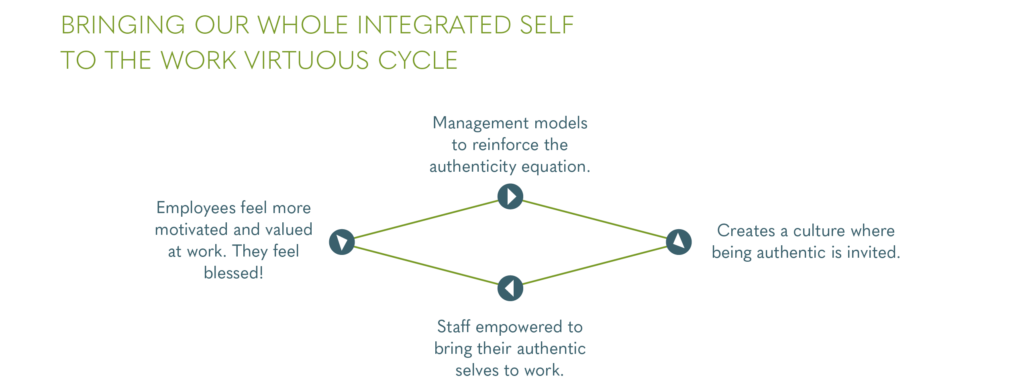
Encourage professionals to bring their personal attributes into their work content and work space. They’ll be more motivated and feel more valued if they are able to bring their entire integrated selves to the work environment.
Work life balance feels impossible to achieve these days, especially during COVID-19. Even work life integration, in which we can selectively mix our two lives together, can prove difficult. Instead, we can stop thinking of work and life as separate. Rather, we can best motivate our employees by bringing ALL of themselves to work – by promoting Authenticity, Humility, and Vulnerability.
How We Enable Our Staff to Bring their Whole Integrated Self to Work
Mike Robbins, in his recently published book Bring Your Whole Self To Work, talks about what the title phrase means to him:
“Bringing our whole selves to work means showing up authentically, leading with humility, and remembering that we’re all vulnerable, imperfect human beings doing the best we can. It’s also about having the courage to take risks, speak up, ask for help, connect with others in a genuine way, and allow us to be truly seen. It’s not always easy for us to show up this way, especially at work. And it takes commitment, intention, and courage for leaders and organizations to create environments that are conducive to this type of authenticity and humanity.”
I highlight authenticity, humility, and being vulnerable as the responsibility managers and leaders have to create the environments necessary for our employees to feel comfortable to show up to work. To that end, I present a series of questions we have to ask ourselves as workers ourselves, and then as managers responsible for others workplace experiences:
- Authenticity: Do we bring our whole integrated selves to work, and do we encourage the people we work with every day to bring their authentic selves? That is, do we present ourselves in the ways that we actually are in other parts of our lives?
- Humility: Do we listen intently to our colleagues before we speak? Do we allow ourselves to share our mistakes and missteps? Do we openly admit that we were wrong? Doe we allow our staff (rather then ourselves) to take the credit?
- Vulnerability: Do we share our fears and our concerns with others, including when we fall short on a project or don’t always have the knowledge to move forward? Do we allow ourselves to hear openly critical feedback and be okay with accepting and reflecting on it instead of refuting or disregarding it? Do we allow others to share openly their vulnerabilities in a safe and inviting space at work?
Once we address these questions, we can broach them with our staff We can then discover whether our teams really feel comfortable to be authentic, humble, and vulnerable in the work place. It may be that they feel the culture hasn’t allowed or invited them to be their full authentic and integrated selves. This can allow us to create a virtuous cycle of bringing our integrated self to work, though the schematic below:

Plan of Action:
So how do we bring this cycle to life? Our actions can include:
- Invite our employees to make their work in their own image
- Mitigate work and life conflicts with transparency – seeking creative and open solutions that can work for the employee and for the organization
- Promote kindness and care for each other at work – and allowing our employees not to expect as much of themselves especially during particularly challenging times.
- Invite employees to “choose” at least some work projects and responsibilities so it can better integrate with their personal interests and needs.
- Offer our employees balance and flexibility in their work schedule, and keep the focus on results and what they are able to deliver for the organization
- Allow professionals 20% of the time to a pursue a passion project that enriches them and benefits the broader mission of the organization
- Promote policies and protocols that reduce gender and other categorical or systemic biases
Our Portrait: Becky Voorwinde

Becky Voorwinde, the Executive Director of the Bronfman Fellowship, works to bring her whole self to work each day. It helps her harness the energy she needs as a busy and passionate executive director who seeks to both deliver results to the organization and nurture her own personal well-being while engaged in work.
She feels fortunate to be in a position in which she feels she can be authentically herself at work, just like she is at home or in other situations. She ensures that she makes time for her in all spaces of her life, be it work, family, or time outside these two buckets, to maintain motivation and to thrive, and she works with her organizational leadership to maintain this working system and ensure it works for the culture and goals of the organization.
Questions for Reflection:
- How might we model authenticity, humility, and vulnerability in the work place for our staff?
- How might we better operate through a gender and racial lens so employees can bring their whole selves to work?
- How might we engage our staff to list the passions, curiosities and interests that light them up and have them share with us? They could also share their interests that may not have been evident until now with you. Employees should also share with us what they need and where they hope to add value. We first must listen and try, as best we can, to align the context of the jobs that need to be done to who our talent is in all aspects of their being.
